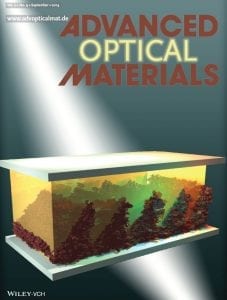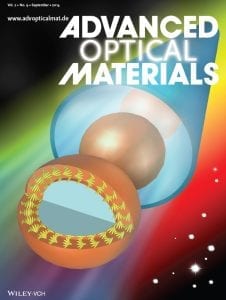The latest issue of Advanced Optical Materials is now available. Don’t miss out: take advantage of the current free access to all Advanced Optical Materials articles by signing up here!
 These articles were highlighted on the covers of the Advanced Optical Materials September issue:
These articles were highlighted on the covers of the Advanced Optical Materials September issue:
Solid-State Lighting
The image shows an artist’s abstraction of digitally controlled RYGB lasers color-mixed to create white light, created by Hanqing Kuang and George Wang. The long-term route to ultra-efficient and smart lighting might well be some variant of this architecture, as phosphors must give way to multi-color semiconductor electroluminescence. The current status of solid-state lighting is reviewed by J. Y. Tsao et al., including some of the associated technological challenges.
Light Harvesting
Patterning one-dimensional gratings on the surface of nanocrystalline titania electrodes is used as a light-harvesting strategy to improve the overall performance of dye solar cells under both frontal and rear illumination conditions. As described by H. Míguez and co-workers, this feature is a key advantage over other light-harvesting efficiency-enhancing methods, in which the performance of the cell under illumination from one of its sides is enlarged at the expense of reducing the output under reverse irradiation conditions.
 Microshells
Microshells
A self-organized, phototunable 3D photonic superstructure is fabricated from a photoresponsive 1D liquid crystal using microfluidics. Q. Li and co-workers show how the resulting monodisperse microshells are water-oil-water double emulsions, in which the oil phase consists of the photoresponsive liquid crystals. The cholesteric microshells exhibit band-edge lasing in all directions, and the wavelength of the resultant band-edge laser is tuned via the pumping laser, causing photoisomerization of the chiral molecular switch.

















